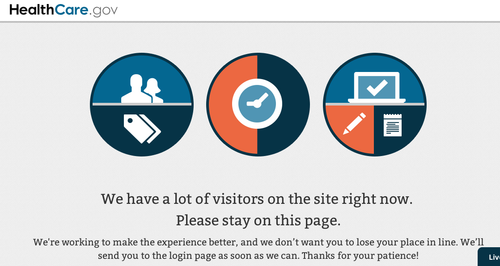(NOTE: The Hawaii Health Connector’s failed website was built under a $53M contract with the same CGI which has made a mess of the federal ACA signup website. Here is a look at the causes from a competing company known as ‘The Department of Better Technology.’)
The Healthcare.gov Fiasco
From The ‘Department of Better Technology’ October 7, 2013
It’s been a week since Healthcare.gov launched, and for anyone who has tried to register for new health insurance on the website, its online waiting room page is perhaps the most recognizable page on the site:

Not only did the site not scale at launch, it was riddled with errors, and it clearly wasn’t ready to go. Just taking a look at the code that runs the site, you can see that it’s riddled with “Lorem Ipsum Dolor” — the placeholder text that web designers and developers use to demonstrate designs before copy has been written. Reddit's gone wild with speculation about who built it and, of course, legions of IT experts have come out questioning the architecture of the website.
The contractors who made this website were at best sloppy, and at worst unqualified for the job. So, why? How did this happen to arguably the most important and lasting website of this president’s administration? And why did such sloppiness cost the taxpayer, from what I can tell, over 600 Million Dollars?
Some may say that this is complicated stuff. That the systems in place that Healthcare.gov had to integrate into various legacy systems, and that the system could only be tested so much, and that building a highly scalableFISMA certified web service was impossible from the get-go. Others might argue that this is the country that invented the Internet, Google, Amazon, Twitter, Facebook, the iPhone, and Android, it isn’t as though we don’t have the technical talent to stand up a website that allows people buy health insurance over the Internet.
But the truth is, they’re both right. But worrying about fixing healthcare.gov is a bit like giving Walter White cough syrup and expecting it to solve all his problems. You might hope his cough will go away, but it certainly isn’t going to end his lung cancer nor convince him to shut down his meth empire.
Healthcare.gov got this way not because of incompetence or sloppiness of an individual vendor, but because of a deeply engrained and malignant cancer that’s eating away at the federal government’s ability to provide effective online services. It’s a cancer that’s shut out the best and brightest minds from working on these problems, diminished competition for federal work, and landed us here — where you have half-billion dollar websites that don’t work.
That cancer is called “procurement” and it’s primarily a culture driven cancer one that tries to mitigate so much risk that it all but ensures it. It’s one that allowed for only a handful of companies like CGI Federal to not only build disasters like this, but to keep building more and more failures without any accountability to the ultimate client: us. Take a look at CGI’s website, and the industries they serve: financial services, oil and gas, public utilities, insurance. Have you had a positive user experience in any of those industries?
The cancer starts with fear. Contracting officers — people inside of the government in charge of selecting who gets to do what work — are afraid of their buys being contested by people who didn’t get selected. They’re also afraid of things going wrong down the line inside of a procurement, so they select vendors with a lot of “federal experience” to do the work. Over time, those vendors have been consolidated into pre-approved lists like GSA’s Alliant schedule. Then, for risk mitigation’s sake, they end up being the only ones allowed to compete for bids.
This results in a culturally accepted idea that cost implies quality. To ensure no disasters happen, throw lots of money at it. And when things go terribly wrong, throw more money at the same people who caused the problem to fix the problem. While this assumption may work well with commodities (want to ensure that you get lots of high-quality gravel? Buy a lot more gravel than you need, then throw out the bad gravel) the evidence points to the contrary with large IT purchases: they usually fail.
On top of this culture of fear? 6,500 pages of regulation, cumbersome business registration processes, and hostile bidding environments ensure that very few new businesses can compete for contracts, and the ones that do end up becoming specialists in those regulatory burdens, not in doing the right thing.
The truth is, the people inside of government would like nothing more than to have the best and brightest minds in the world working on Healthcare.gov. But the best they’ve got to choose from are 58 different companies. That’s *the* problem.
In order to solve the healthcare.gov problem, we’ve got to stop worrying about the cough, and start worrying about the cancer. We’ve got to start worrying about the systemic issues that allow for healthcare.gov to happen, not the “Lorem Ipsums” sprinkled in the javascript source code of the website.
If we’re so worried about fixing the federal budget, why don’t they shut down the government until we fix the way we buy things. We’ve got to demand a more competitive, more diverse, and more innovation friendly federal contracting environment so that government can get access to the best and brightest minds available to solve our common problems. America is the home of the top innovators on the planet. Government should let them in.
---30---
Related National Coverage: